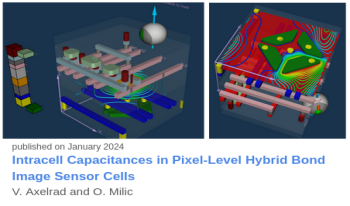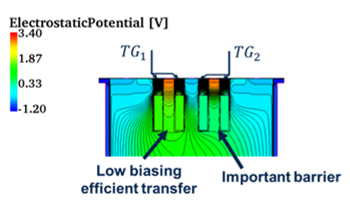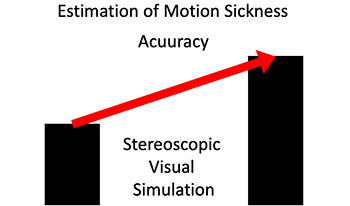
Accurate coupling capacitances are a key part in the design of modern image sensor cells due to their high speed requirements, large number of active devices and interconnects, and complex inter-layer dielectric structure. Automation of 3D structure creation integrated with the design flow as well as speed and robustness of capacitance calculation are crucial for a seamless design and optimization flow. Periodicity of image sensor arrays necessitates availability of periodic boundary conditions. High structural complexity (many layout elements, many metal interconnect levels and many dielectric layers) demands efficient numerics for reasonable runtimes. We apply a new integrated software package CellCap3D to the calculation of image sensor cell capacitances with the specific example application of comparing a Pixel-Level Hybrid Bonding (PLHB) cell to its conventional counterpart where hybrid bonds are only utilized along the periphery of the die. PLHB is a recently proposed approach which introduces an electrical contact between light-sensing (bottom) die and upper die for every pixel. A hybrid-bond, in essence a small-pitch, small-size Cu-Cu contact, now allows addition of extra MOS devices and capacitors to the individual pixel, thus greatly expanding imager functionality and performance. Additional benefit is achieved in simplification of the manufacturing of the light-sensing die. A reduction in the number of manufacturing steps, also reduces the chance of defect introduction. The architecture of the simulation system, some key components and numerical aspects are discussed in this work. The software produces a complete capacitance matrix for a typical image sensor cell with 5-7 interconnect layers in minutes on a standard Linux machine. Lithographic distortions of layout patterns, as demonstrated in the example in this work, can be optionally included for more physically accurate capacitances. Misalignment of mask layers or bonded wafers relative to each other can be considered for its effects on coupling capacitances. Periodic boundary conditions can be used for periodically repeated image sensor cells, avoiding the need to simulate an array of cells to provide the correct electrostatic environment for one cell.

The integration of trench vertical transfer gates in an indirect time of flight pixel has been studied through TCAD & optical simulations. A small fast photo-gate pixel surpassing state of the art performances has been designed and optimized thanks to these advanced multiphysics simulations. Quantum efficiency of 40% is obtained and demodulation contrast of 89% at 200MHz is achieved while transfer gates operate at 1.0V biasing.

Automation of driving leads to decrease in driver agency, and there are concerns about motion sickness in automated vehicles. The automated driving agencies are closely related to virtual reality technology, which has been confirmed in relation to simulator sickness. Such motion sickness has a similar mechanism as sensory conflict. In this study, we investigated the use of deep learning for predicting motion. We conducted experiments using an actual vehicle and a stereoscopic image simulation. For each experiment, we predicted the occurrences of motion sickness by comparing the data from the stereoscopic simulation to an experiment with actual vehicles. Based on the results of the motion sickness prediction, we were able to extend the data on a stereoscopic simulation in improving the accuracy of predicting motion sickness in an actual vehicle. Through the performance of stereoscopic visual simulation, it is considered possible to utilize the data in deep learning.

Automation of driving leads to decrease in driver agency, and there are concerns about motion sickness in automated vehicles. The automated driving agencies are closely related to virtual reality technology, which has been confirmed in relation to simulator sickness. Such motion sickness has a similar mechanism as sensory conflict. In this study, we investigated the use of deep learning for predicting motion. We conducted experiments using an actual vehicle and a stereoscopic image simulation. For each experiment, we predicted the occurrences of motion sickness by comparing the data from the stereoscopic simulation to an experiment with actual vehicles. Based on the results of the motion sickness prediction, we were able to extend the data on a stereoscopic simulation in improving the accuracy of predicting motion sickness in an actual vehicle. Through the performance of stereoscopic visual simulation, it is considered possible to utilize the data in deep learning.


Ancient documents were often created by overwriting older documents that had been erased to re-use the expensive parchment. There is thus the situation that we have valuable documents that actually contain possibly more valuable documents “underneath”, hidden to the human eye. Being able to retrieve these originals is an important task, however, associated with several problems. One of these is that the value of the documents limits the distribution and thus the ability to experiment. Another is that the “to be discovered” underwriting might hold important information that should first be examined, classified and put into context by textual scholars, again severely limiting the ability to experiment. This is a strong decrement to scientists and students involved in developing and testing imaging algorithms.This paper describes an approach to create artificial palimpsests that are reasonable approximations based on previous example and thus can be used by everybody to test new assumptions, new algorithms and to study the interaction of the different deterioration mechanisms.

Developing an augmented reality (AR) system involves a multitude of interconnected algorithms such as image fusion, camera synchronization and calibration, and brightness control, each having diverse parameters. This abundance of features, while beneficial in nature for its applicability to different tasks, is detrimental to developers as they try to navigate different combinations and pick the most suitable configuration for their application. Additionally, the temporally inconsistent nature of the real world hinders the development of reproducible and reliable testing methods for AR systems. To help address these issues, we develop and test a virtual reality (VR) environment [1] that allows the simulation of variable AR configurations for image fusion. In this work, we improve our system with a more realistic AR glass model adhering to physical light and glass properties. Our implementation combines the incoming real-world background light and the AR projector light at the level of the AR glass.

Abstract A three dimensional calculation of a first transfer subsystem in electrophotography is carried out and toner scattering on a transfer belt is simulated. This simulation consists of an electric field calculation and a toner movement calculation, and toner scattering around the periphery of the dot is investigated. The simulation shows that the formation of toner scattering arises from the toner jumping across the transfer gap before the photoconductor contacts the belt. The effects of transfer parameters on toner scattering are investigated with the simulation. To prevent toner scattering, the position of the roller, adhesion force, transfer bias, toner charge, and resistivity of the belt should be optimized to create an appropriate electric field distribution, and so that the toner transfer occurs in a small gap or in a contact nip between the photoconductor and the belt.